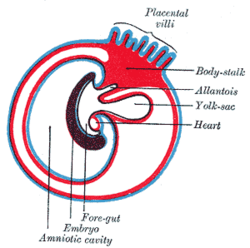Foregut tube
| Foregut | |
|---|---|

|
|

Termination of the foregut.
|
|
| Details | |
| Carnegie stage | 9 |
| Precursor | Mesenchyme |
| Identifiers | |
| Latin | Praeenteron, proenteron |
| TE | E5.4.4.0.0.0.2 |
| FMA | 45616 |
|
Anatomical terminology
[]
|
|
The foregut is the anterior part of the alimentary canal, from the mouth to the duodenum at the entrance of the bile duct, and is attached to the abdominal walls by mesentery. The foregut develops from the folding primitive gut, and is developmentally distinct from the midgut and hindgut. Although the term “foregut” is typically used in reference to the anterior section of the primitive gut, components of the adult gut can also be described with this designation. Pain in the epigastric region, just below the intersection of the ribs, typically refers to structures in the adult foregut.
The enteric nervous system is one of the major divisions of the nervous system derived from neural crest cells. In mammals, it is composed of large number of interconnected ganglia that are arranged into two concentric rings embedded throughout the gut wall, beginning in the esophagus and ending in the anus. The main function of the ENS is to control the secretory activity of the gastrointestinal glands and peristalsis of the gastrointestinal wall. A large number of organs derived from the developing foregut also receive input from the vagus nerve, which also works in tandem with the ENS to control gastrointestinal function.
The foregut develops from a cranial region of endoderm created after the initial cephalocaudal folding of the embryo. Starting at the stomodeum, a rapid expansion of the primitive gut forms the esophagus, from which the respiratory bud branches off.During early foregut development, the esophagus lengthens considerably, reaching its proportional postnatal size. Simultaneously, the stomach begins to expand in width dorsally and ventrally in an asymmetric manner. This asymmetric expansion creates two curvatures, with the ventral side creating the lesser curvature and the dorsal side creating the greater curvature.The expanding dorsal stomach wall then rotates the on its transverse plane, pulling its caudal portion upward and forcing the upper duodenum into a C shape. This rotation positions the left vagus nerve anteriorly and right vagus nerve posteriorly.
...
Wikipedia
